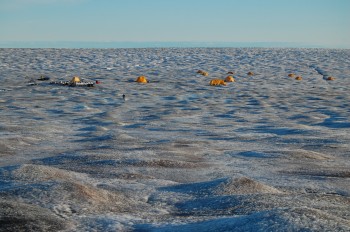Slowing Greenland’s Ice Sheet from Below
October 22, 2015
Surface & Hydrologic Processes

A team led by scientists from the Institute for Geophysics has for the first time directly observed multiple parts of Greenland’s subglacial plumbing system and how that system evolves each summer to slow down the ice sheet’s movement toward the sea.
These new observations could be important in accurately modeling Greenland’s future response to climate change.
“Everyone wants to know what’s happening under Greenland as it experiences more and more melt,” said study coauthor Ginny Catania, a research scientist at the institute and an associate professor in the Jackson School of Geosciences.
Each summer, the surface of the Greenland ice sheet melts as temperatures warm, sending meltwater into channels that drain to the bottom of the ice sheet, lubricating the underside and speeding up the ice sheet’s flow toward the sea. These new observations clarify scientific understanding of how this plumbing system evolves each summer and how it may change in the future as the climate continues to warm.
The findings, published Oct. 2, 2014, in Nature, describe an efficient drainage system in which meltwater from the surface drains into moulins, naturally formed pipes that drain water through more than half a mile of ice to passageways between the bedrock and overlying ice.
The scientists found that while the extra meltwater does cause a rapid daily speedup of the ice sheet, the ice gradually becomes less and less sensitive to melting over the course of the summer season. This behavior suggests that a component of the subglacial plumbing system is adapting to the increased meltwater, said lead author Lauren Andrews, a doctoral student at the Jackson School.
Back to the Newsletter